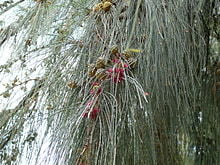Casuarina

Casuarina is a genus of 17 tree species in the family Casuarinaceae, native to Australia, the Indian subcontinent, southeast Asia, islands of the western Pacific Ocean, and eastern Africa. It was once treated as the sole genus in the family, but has been split into four genera (see: Casuarinaceae).[1][3]
Casuarina equisetifolia at Chikhaldara, India
They are evergreen shrubs and trees growing to 35 m (115 ft) tall. The slender, green to grey-green twigs bearing minute scale-leaves in whorls of 5–20. The apetalous flowers are produced in small catkin-like inflorescences. Most species are dioecious, but a few are monoecious. The fruit is a woody, oval structure superficially resembling a conifer cone, made up of numerous carpels, each containing a single seed with a small wing.[3][4] The generic name is derived from the Malay word for the cassowary, kasuari, alluding to the similarities between the bird’s feathers and the plant’s foliage,[5] though the tree is called rhu in current standard Malay.
Karen Louise Wilson and Lawrence Alexander Sidney Johnson distinguish the two very closely related genera, Casuarina and Allocasuarina on the basis of:[6]
Casuarina: the mature samaras being grey or yellow brown, and dull; cone bracteoles thinly woody, prominent, extending well beyond cone body, with no dorsal protuberance;
Allocasuarina: the mature samaras being red brown to black, and shiny; cone bracteoles thickly woody and convex, mostly extending only slightly beyond cone body, and usually with a separate angular, divided or spiny dorsal protuberance.
